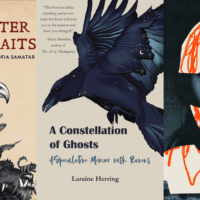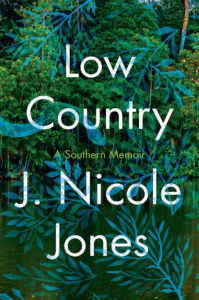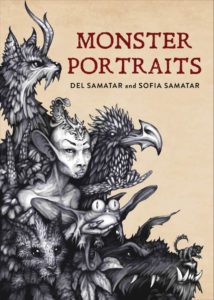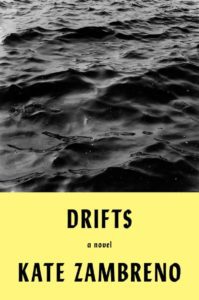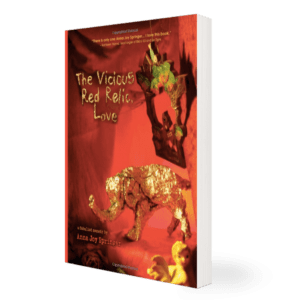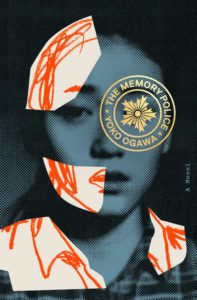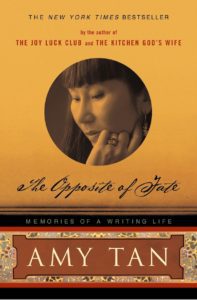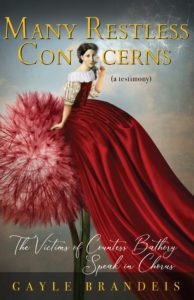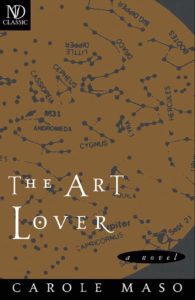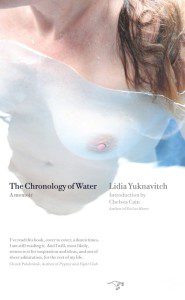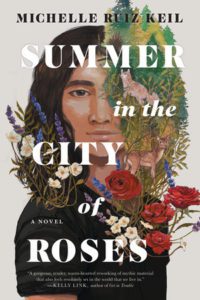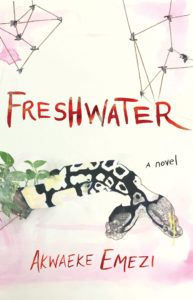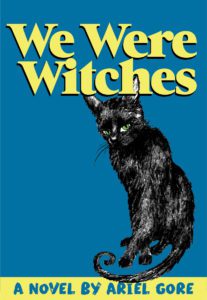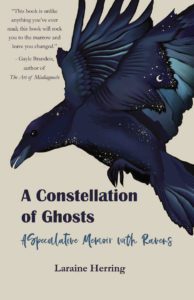You’re looking around your room, wondering if that’s a ghost you see behind the curtain, or if it’s just your imagination. Then you wonder why you put a “just” before your imagination. As if imagination is anything less than the foundation of everything. As if it could be minimized. And then you wonder if there’s a part of you that believes your inner world—your dreams and hauntings and fantasies—are less than because only you experience them. You wonder who taught you that. You wonder why you believed them.
Still, you can’t quite shake your intuition—she’s a stubborn one. You creep closer to the curtain, notice disturbances in the folds of fabric, and you know. You know but you can’t prove. And then you wonder who taught you that only things that are provable by others mattered. You wonder why you believed them.
If you continue with your exploration, you may remember the whisper of your childhood imaginary friend, the way you wondered what might have happened if you’d made a different choice, or the way you imagined alternate scenarios in the dark and how those imaginings helped you make choices in the light. You smile to the ghost that may or may not be behind the curtain because you’ve remembered it doesn’t matter whether there’s a ghost there or not.
What matters is that your understanding of that ghost changed you. And when you understand that, you’re ready to write your own speculative memoir!
The books on this list, though not all speculative memoirs, each came into my life at the perfect time to help me find the courage to own my own voice and perspective. I hope they do the same for you.
***
Low Country: A Southern Memoir by J. Nicole Jones
Low Country busts apart traditional memoir structure in favor of the cadence of a good old Southern ghost story. Weaving the ghost stories of South Carolina low country where Jones was raised with the complicated stories of her family, Jones creates a tapestry where one story layers onto another, each one revealed as intimately connected to the other. She reflects, “Stories, like anger and ghosts, come more alive with every repetition… Here we chuck out Aristotle in favor of the forms of women who tell stories shaped like themselves that history made a point of forgetting. The stories of women, like their bodies and lives, are fuller, rounder, softer. Prone to repetition. Like love. Like songs. Like ghosts.” Yes, yes, and yes. I’m always interested in how what I’m reading opens up possibilities for my own writing, and this book is a great example of how to integrate folklore, local legends, and cultural context to elevate your memoir.
Monster Portraits by Sofia and Del Samatar
Sofia Samatar, discussing her book Monster Portraits, said, “When I was writing my own uncanny autobiography, Monster Portraits, I felt this incredible breadth, the license to incorporate anything. I was myself, my own memories were there, yet I also inhabited a series of monsters. And each monster revealed another facet of my thinking or experience.” Monster Portraits is an illustrated book—Sofia wrote the text and her brother, Del, created the stunning illustrations. I was taking a class on speculative nonfiction from Naomi Kimball, and she used this book as a text. Not only is it delightfully speculative, but it’s hybrid and a gorgeous reflection on the ways we can use the imagination to create tangible characters that help bring us deeper into relationship with ourselves.
Drifts by Kate Zambreno
Drifts is classified as a novel (a testament to how slippery classifications are), but it is, to me, a series of philosophical essays braiding together Zambreno’s life with the journeys of other writers, such as Rilke, and painters, such as sixteenth-century artist Albrecht Durer. It’s a long braided essay. It’s a philosophical text. It’s a novel. It’s peppered with the author’s photographs of the mundane as well as “great” art, opening up a line of questioning about what is worthy of contemplation—what is worthy of being capital-A Art. It’s also a lot about her guru-dog Genet. Wicked smart and relentless in its questioning about what it means to write, to engage with ideas, and to do it while female, Drifts validated so much of my own meandering process while also reminding me of the importance of holding on to the ideas that haunt us long enough to uncover the gifts they’re bringing us.
The Vicious Red Relic, Love: A Fabulist Memoir by Anna Joy Springer
This gorgeous gem of a book brings together so many ways of storytelling into a meditation on loss, lust, and trauma. Springer also illustrated this book, and you’ll want to take the time to study every page. Each sentence is a universe, and there are so many details in the art that enrich the storytelling, you’ll have return to the book many times to fully appreciate its genius—and just like with our own memories, each time we return, we uncover something new. The book is structured into parts called “Forests,” such as “The Forest of Mandatory Innocence” and “The Forest of Molestations Cliches.” We travel with Springer into these Forests, accompanied by her friend, Blinky, who is made out of aluminum foil. What more do you need to know to rush out and get this book?
The Memory Police by Yoko Ogawa
This novel, translated from Japanese by Stephen Snyder, presents an incredibly poignant dramatization of grief and loss. Set on an unnamed island, the Memory Police, who are similar to storm troopers, enforce the erasure of things living and non-living. Just like in life, there’s never an explanation as to why something is “disappeared.” Sometimes the disappeared thing is a calendar. One day it’s birds. Another day it’s roses. As each loss accumulates, the residents of the island adapt, losing more and more of themselves with each loss. “When the hats disappeared, the milliner down the street began making umbrellas.” There are some residents, however, who don’t automatically forget the things that are being disappeared, and they are a threat to the Memory Police and are therefore hunted. I couldn’t help thinking about complicated grief—how we can be sometimes too affixed to or too detached from the object of the loss. Both forms were present in this sad novel about the relationships that define us and shape us, and what happens if those things vanish. Though a novel and not a speculative memoir, the sentience given to the objects that vanish reminded me of the interconnectedness of everything—the certainty that there is magic and possibility in every single encounter.
The Opposite of Fate by Amy Tan
This memoir speaks to any writer (or human) who needs a reminder to trust their intuition and follow their own ghosts and paths into the story that is calling to them. The book opens with Tan reading the Cliff’s Notes version of her own book, The Joy Luck Club, and being amused at all the things she supposedly did in the text that she had no idea she’d done. “In page after chilling page,” she writes, “I saw that my book had been hacked apart, autopsied, and permanently embalmed into chapter-by-chapter blow-by-blows: plot summaries, genealogy charts, and—ai-ya!—even Chinese horoscopes.” Reading this hilarious passage helped me separate myself from reviewers and critics and helped me feel less of a fraud—no, I don’t really know why I made every single choice in my book. I just did what I did. I listened to my story and tried to do right by it. The Opposite of Fate made me feel seen when I felt most invisible.
Many Restless Concerns: The Victims of Countess Bathory Speak in Chorus by Gayle Brandeis
This novel-in-poems not only busts open form, but it embodies the heart of the speculative—giving voice to that which cannot speak. In this short but powerful book, the victims of Countess Bathory’s brutality (yes, she was a real person) speak in a collective “we” about what they endured under her cruelty. My favorite line, out of so many, is towards the end. The line is: “(maybe story is the blood of ghosts).” I love the juxtaposition of something as visceral as blood against the ethereal “ghost,” and of course, story is the lifeblood of humans, too. Ultimately a feminist call to resurrect our silenced voices, this book will rock your soul.
The Art Lover by Carole Maso
I read this book when it was released in 1990, and when Carole Maso came to read at the University of Arizona, where I was an undergraduate English major, I was first in line to see her. The room wasn’t nearly as crowded as it should have been for a woman of such exceptional talent. In the thirty years since, Maso has continued to create groundbreaking book after groundbreaking book, but The Art Lover changed me. In school, I was discouraged by male-focused narratives. Uninspired by the upside-down checkmark. And this book—a collage of memoir, fiction, maps, star charts, and photographs—showed me that a text could be anything. Released long before now-popular and mainstreamed hybrid forms, The Art Lover moved me like no other book before or since. It’s a meditation on grief, an elegy to Maso’s best friend who died from AIDS, a love song to a brilliant father, and a testament to the possibility of art.
The Chronology of Water by Lidia Yuknavitch
Of course, read all the Yuknavitch. Read her for what language can do. Read her for permission for you to write your story in the way you must. Read The Chronology of Water for this: “All the events of my life swim in and out between each other. Without chronology. Like in dreams. So if I am thinking of a memory of a relationship, or one about riding a bike, or about my love for literature and art, or when I first touched my lips to alcohol, or how much I adored my sister, or the day my father first touched me—there is no linear sense.” (And that’s just the second page). Look how that sentence blows open with recognition and acceptance of what we’ve always known about our own lives, even when we felt forced to conform it to an upside-down checkmark and the trajectory of a male orgasm. Read Yuknavitch to realize your own power.
Summer in the City of Roses by Michelle Ruiz Keil
This new YA novel is the best of everything—a ferociously intelligent protagonist, a boy who turns into a deer, bringing in all the best of mythology, witchcraft, and transmogrification—all set in Portland! It’s a testament to the power of intelligence, stories, and acceptance to explode a life open. Keil merges the magical into the real seamlessly (as if there’s a difference anyway!) and by the end of the book, we know there’s a place we can go to turn into what’s next for us, and even more importantly, we know that whatever it is, we’ll be okay.
Freshwater by Akwaeke Emezi
I read this in a single sitting. It’s the debut novel from Emezi (please read all their work!) and it captivated me first for its language. It follows the story of Ada, a troubled child who is born “with one foot on the other side.” It’s narrated by the ogbange, (godly parasites with many heads), that live in Ada’s head, and as she matures, they dominate her life and choices. To say Freshwater is about the unification and separation of bodies and souls is just to skim the surface of what this text reveals. To say it’s about being between genders is far too simplistic. As a writer, I’m in awe of their prose and the way they build empathy for not only our protagonist, but for all the spirits that inhabit her. There is so much love in this book, as well as terror and wonder. Take this, narrated by “WE,” which are the ogbange: “This is all, ultimately, a litany of madness—the colors of it, the sounds it makes in heavy nights, the chirping of it across the shoulder of the morning. Think of the brief insanities that are in you, not just the ones that blossomed as you grew into taller, more sinful versions of yourself, but the ones you were born with, tucked behind your liver. Take us, for instance.” This book stretched my perspective and, like so many books on this list, gave me permission to write what I was afraid to say.
We Were Witches by Ariel Gore
Ariel Gore’s work has long sustained me. In We Were Witches, she tells the story of being a single mom, finding her way as a writer and a lesbian, and along the way, as one does, taking time to fight the patriarchy. My speculative memoir was inspired by a prompt from Ariel Gore’s Saturday Morning Prompts, and some of the book was conceived in her Literary Kitchen classes. This book is labeled a novel, but you’ll see it on many speculative memoir lists. Genre is fuzzy. Labels are for canned goods. This book will make you believe in magic, and more than that, remind you of who you were before others told you differently.
And to close out this wonderful list, we just had to include Laraine’s new book, A Constellation of Ghosts: A Speculative Memoir with Ravens, forthcoming on October 19 from Regal House Press! – Ed.
A Constellation of Ghosts: A Speculative Memoir with Ravens by Laraine Herring
When Laraine Herring receives an unexpected colon cancer diagnosis, her father, thirty years dead, returns to her as a raven, setting off a magical journey into complicated grief, inherited trauma, and ancestral healing. As she struggles with redefining her expectations for her life, she slips farther and farther underground into the ancestral realm, where she finds herself writing a play directed by her father-as-raven. It will be a cast of only four: you and me and my mother and my father, and we will speak until there are no more words between us, says Raven. And then you can decide the ending. Tick, tock, write. With one foot in her old life and one foot in the next, Herring grapples with how the silences around her father’s polio and the judgments of her fundamentalist grandparents shaped her, and as she wrestles with the uncertainty of her future, she must decide what to carry forward and what to leave behind. Utilizing speculative elements and an innovative structure blending lyrical prose with a script format, A Constellation of Ghosts takes the reader into the liminal spaces between one world and another, where choices unspool into lives, and the stories we’ve told ourselves fall apart under the scrutiny of multiple perspectives like flesh from bone, reminding us that grief is the unexpected ferryman who can usher all of us back together again.
